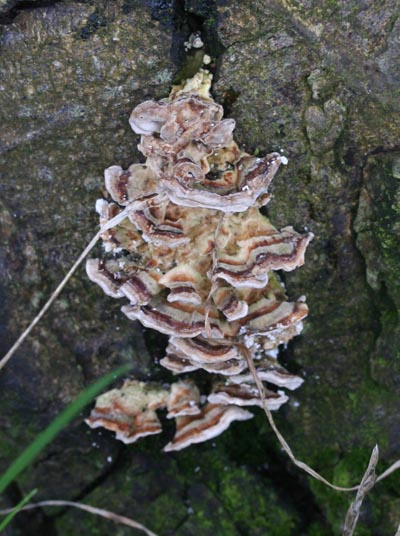The first thing I noted was Daldinia concentrica, more popularly known as King Alfred's cakes:
 |
| Daldinia concentrica - King Alfred's Cakes |
They range in size from golf-ball to cricket-ball and most definitely look like burnt cakes. Surprisingly, this is the first time I've seen it, although I've been aware of its existence for some time. Specimens of Daldinia are very tough, and it's no great surprise to learn that they are the favoured (sometimes only) dwelling-place of various beetles. New to my Species list.
Notice the turquoise area of bare wood to the left. That's Chlorociboria aeruginascens, also known as 'Green Oak' (although I initially thought my dead tree was Beech, and Chlorociboria aeruginascens is sometimes found on Beech, as is the Daldinia):
 |
| Chlorocibaria aeruginascens - 'Green Oak' |
Green Oak was very popular for use in Tunbridgeware due to its bright green/blue addition to the more usual cream, yellow and brown of wood colours. Note the small holes in and around the green area, showing that the dead wood is home to more beetles. The beetles and fungi are doing what they do best: recycling dead wood and returning it to the soil. Also new to my Species list.
I also found patches of Flammulina velutipes in various places on the tree:
 |
| Flammulina velutipes - Velvet Shank |
Its common name Velvet Shank is a translation of the latin velutipes, indicating the dark, velvety stipe ('stem'), although I have noticed in the past that many specimens actually have a pale, smooth stipe. Just to be sure, I put a couple of specimens on a glass slide and they reluctantly dropped a few white spores for me:
 |
| Flammulina velutipes spores at x 400 |
At the bottom of the tree I noticed a single group of Turkey Tails - Trametes versicolor:
 |
| Turkey Tails - Trametes versicolor |
So that's a few more specimens for the 1k challenge, including two 'lifers'. The challenge total is now 218 species.
4 comments:
Fungi are incredibly versatile aren't they - and brilliant at colonising any surface suitable for them. Sad that poor old Alfred is remembered for nothing other than burning the cakes (wonder if it has a grain of truth in it).
This reminds me of my grandfather and his hatred of mulberry trees. There were several of them on the farm. Grandpa did not like them because birds ate the fruit and left messy droppings on everything. One of the trees was in the yard near the corner of the house. Grandpa saw what happened to Grandma's laundry on the line. He was so mad that he cut the tree down. He chopped the stump into shavings and poured lime on what was left just to make sure the job was done. All of us kids loved the ease with which we could pick the mulberries from the bush that grew from the mutilated stump that had once been a huge mulberry tree.
Interesting - keep your eyes on that blue fungus, in autumn you should see little cup-shaped fruiting bodies (same colour) - I've only ever seen it once, on a fallen branch of an unknown broadleaf - sadly it dint' re-appear the next year.
Weaver: one of my special interests is the relationship between species, and no matter where you start in a dependency chain, you usually end up encountering a fungus whether you go up the chain or down the chain.
Emma: I'm pretty keen on growing my own vegetables and a few years ago I cut up a willow twig to use as plant ties. At the end of the season I had a row of willow saplings growing across my vegetable plot.
Gill: The green colouration of the wood is the mycelium, which is persistent. The fruit bodies are apparently quite scarce. I suppose they are only produced when conditions are suitable (whatever 'suitable' means in this instance).
Post a Comment